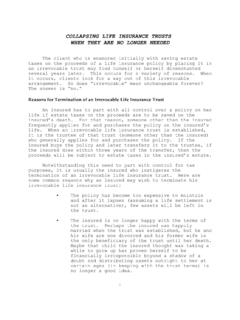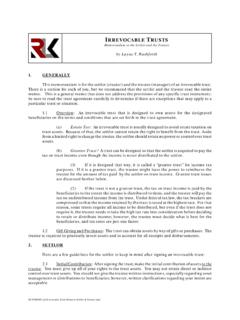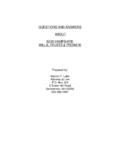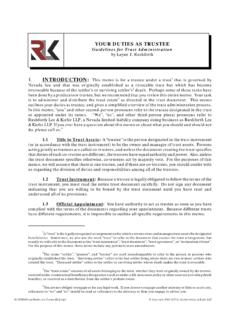Transcription of TAXATION AT ATURITY CASH VALUE LIFE INSURANCE
1 2008 The Madison Group, Inc. page 1 of 3 TAXATION AT MATURITY: CASH VALUE life INSURANCE Is your client s life INSURANCE at risk of creating additional TAXATION ? Older cash VALUE life INSURANCE policies are typically set to mature at a specified age (generally age 95 or 100). This means if the insured is still alive at the time the policy matures, the cash VALUE of the policy is paid to the policy owner in lieu of the death benefit. With the advancement of health care, and thus the resulting increase in life expectancy, it is now quite possible that some clients may outlive their coverage.
2 These clients may face a taxable event if their policy matures during their lifetime and becomes payable. Additionally, some universal life policies have low cash surrender values, so a client would face a taxable event to the extent that the proceeds exceed basis, as well as, proceeds may be far less than the anticipated death benefit. If my client s policy matures prior to the insured s death, the policy will typically pay out its cash VALUE . How will this sum be taxed? If the policy matures prior to an insured s death, it ceases to be life INSURANCE and is treated as a taxable distribution.
3 As such, the cash VALUE will be taxed as ordinary income to the extent it exceeds the taxpayer s basis into the policy ( , the sum of after-tax premiums). If the policy is owned by an individual, the individual pays the income tax and the proceeds would now become part of the individual s estate. Most current cash VALUE policies have resolved this issue by offering maturity extension riders, allowing the policy to continue until the death of the insured(s), and thus, in most cases, allowing the death benefit to be received income tax 1 For federal income tax purposes, life INSURANCE death benefits generally pay income tax-free to beneficiaries pursuant to IRC Sec.
4 101(a)(1). In certain situations, however, life INSURANCE death benefits may be partially or wholly taxable. Situations include, but are not limited to: the transfer of a life INSURANCE policy for valuable consideration unless the transfer qualifies for an exception under IRC Sec. 101(a)(2)( , the transfer-for- VALUE rule); arrangements that lack an insurable interest based on state law; and an employer-owned policy unless the policy qualifies for an exception under IRC Sec. 101(j). 2008 The Madison Group, Inc. page 2 of 3 How is this sum treated in terms of income tax and estate tax when received by a trust?
5 2 If the policy is owned by an irrevocable trust, the trust is responsible for payment of the income tax. If the policy is owned by an irrevocable trust, and the insured has no incidents of ownership in the policy, the proceeds should not be included in the estate. If the trust is a grantor trust for income tax purposes, the trust grantor is responsible for payment of all income tax. Additionally, the proceeds are likely to be included in the grantor s estate. If an annuity option is chosen as the pay-out option for these proceeds, what are the resulting tax implications?
6 An annuity option is merely a 1035 exchange of the life policy into an annuity. This defers income TAXATION until distributions are received. Usually an immediate annuity is chosen, which effectively transfers the owner s basis from the life INSURANCE policy to the annuity. A portion of each annuity payout, representing the return of after-tax premium payments made to the life INSURANCE policy, would be received However, the other portion of each annuity payout would be subject to income TAXATION . It is also possible to roll the life policy proceeds into a deferred annuity and defer the income taxes entirely until a future date.
7 However, if the policy is owned by an irrevocable trust, this option may not be practical, as deferred annuities owned by non-natural persons, ( , trusts),) generally do not receive tax deferred growth. How do I find out if my clients have one of these policies? life INSURANCE can be a complex financial instrument. Like other assets, a life INSURANCE policy needs to be monitored to assure it performs according to expectations and continues to be appropriate for your clients particular planning goals. Regular policy reviews are highly recommended.
8 As part of our policy review process, The Madison Group, Inc., routinely checks for potential issues, including whether the policy could potentially mature during the client s lifetime. Do trustees have additional responsibilities in monitoring these policies? Trustees generally have a fiduciary duty to invest and manage trust assets as a prudent investor would. This includes not only traditional investment assets, but other frequently overlooked assets such as life INSURANCE . Trustees who breach this duty may be liable for monetary damages to the trust beneficiaries, therefore, regular policy reviews help satisfy the trustee s fiduciary responsibility, ensure the life INSURANCE is performing as expected, and provide the best possible benefit for trust beneficiaries.
9 2 The federal estate tax exemption amount is $2,000,000 in 2008 and increased to $3,500,000 in 2009. The highest federal estate tax rate is 45% in 2008-2009. The federal estate tax will be repealed on 1/1/10 until 12/31/10. Beginning 2011, the federal estate tax will be reinstated with a federal estate tax exemption amount of $1,000,000 and a maximum estate tax rate of 55%. Congress continues to discuss and consider legislation that, if passed, would permanently repeal or otherwise lessen the impact of the federal estate tax.
10 3 Tax-free income assumes: (1) withdrawals do not exceed tax basis (generally, premiums paid less prior withdrawals); (2) policy remains in force until death; (3) withdrawals taken during the first 15 policy years do not occur at the time of, or during the two years prior to, any reduction in benefits; and (4) the policy does not become a modified endowment contract. See IRS Sections 7702(f)(7)(B), 7702A. Any policy withdrawals, loans, and loan interest will reduce policy values and may reduce benefits. 2008 The Madison Group, Inc. page 3 of 3 What is a Policy Review?







